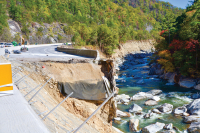Ridgetop towers OK’d in draft Jackson ordinance
 Cell phone towers will now be allowed on Jackson County ridgetops — at least according a draft ordinance that’s on its way to commissioners after meeting planning board approval last week.
Cell phone towers will now be allowed on Jackson County ridgetops — at least according a draft ordinance that’s on its way to commissioners after meeting planning board approval last week.
The final vote on the draft ordinance was unanimous, but the votes and discussion leading up to that final show of hands — especially the ridgetop-oriented part of the discussion — were not.
“At some point I think we come to a point where we’ve heard virtually every argument and we start repeating ourselves,” said board chairman Clark Lipkin as the meeting got rolling. “If we can restrain ourselves from repeating ourselves, we’ll move forward.”
It took a lot of conversation, though, before the board made it to a vote on the big question: should cell towers be allowed on ridgetops, or should ridgetop towers be approved only in special circumstances?
“My argument is it sounds bad when you say you’re going to allow things on a ridgeline. It just sounds bad,” said board member Scott Baker. “But when you look at where we’ve got them now and that’s the kind of coverage we’re getting with them, seeing that small speck on the ridgeline is much less offensive to me than seeing one here in the valley, right here in our face.”
“I think when you put a tower in an already-developed area, there are a lot of things I would rather not look at that are called development in our county, and they’re not pretty,” countered board member Sarah Graham. “I would rather see development of this type around other development than I would on a protected ridgeline, on principle.”
Related Items
Some board members thought that the discussion of aesthetics was a moot point altogether.
“We talked to 20, 30 people in the last month, and there might have been five or six people that even knew where they were,” said board member Dickie Woodard. “Talk to the general public, ask them how they feel about cell towers and ask them to name off where those cell towers are. They don’t even know.”
And some members argued that a cell tower placed on a ridgetop spreads its signal wider and reaches more people than one tucked away in the valley. Prohibiting tower construction on ridgetops would make the business case of coming to Jackson County weaker for tower companies and would mean constructing more towers in order to achieve the same coverage, they said.
“If a company’s deciding whether to come to Jackson County or not and they say, ‘I need 5,000 people and there’s 2,500 people on one side and 2,500 on the other, they’re not going to put it up unless it’s on a ridge,” Lipkin said.
“I think that we should, in the spirit of protecting our mountains, honor that, and if that place is the only place that they can get the service they need, there is a process written into this ordinance for them to present that argument,” Graham responded.
“I think we’re in fundamental disagreement here,” Lipkin said.
“I know we are,” Graham responded.
The board went through another round of talk on the matter before Lipkin brought it back for a vote.
“I could give plenty of arguments and counter-arguments, but it comes down to does this board want to allow towers on ridges?” he said.
The answer turned out to be yes. Lipkin, Baker, Woodard and David Brooks voted against Graham’s proposal to require companies to garner special permission to build on a ridge. Graham, Ron Story and Burt Kornegay voted in favor of the additional hurdle to ridgetop building.
Standards for ridgetop towers
Next, the board had to decide which standards ridgetop towers would have to adhere to. In a split vote, members opted to use the county definition of a ridgetop, which applies to anything that’s at least 2,500 feet high with a 400-foot drop to the valley. That covers a wider territory than the narrower state definition, which applies to ridges that are 3,000 feet tall with a 500-foot drop to the valley.
Kornegay, Graham, Story and Scott voted to adopt the county standard, while Woodard, Brooks and Lipkin voted for the state standard.
An earlier draft of the ordinance had regulated ridgetop tower height on the basis of how high the surrounding tree canopy was. According to that version, cell towers could not be more than 30 feet higher than the average canopy height within 500 feet of the tower. If the tower housed multiple antennae, it could be 40 feet higher.
In this go-around, the planning board opted to strike that stipulation in favor of a more uniform standard.
“It just seems like a lot spinning your wheels up there of things that are constantly changing when it’s only 20 or 30 feet of difference,” Woodard said of the canopy height rule.
“I agree,” Lipkin said. “Let’s just assume an 80-foot canopy whether it’s fully grown or not.”
That proposal met with favor from the rest of the board, which voted unanimously to allow a uniform height for ridgetop towers. The draft would allow towers to be 110 feet high if they feature a single antenna or 120 feet high if multiple receivers are housed on the same tower, called co-location.
Ridgetop cell towers would also have to be at least a half mile from any public road, 1 mile from any other wireless structure, built as a monopole and either not visible or at least 2 miles from the Blue Ridge Parkway. The board approved all those stipulations unanimously.
Keeping max heights the same
Though the board discussed changing the maximum allowed height of cell towers — not just on ridgetops but anywhere — they ended up agreeing to keep the maximum of 180 feet and baseline of 100 feet.
Companies can gain height in increments of 20 feet for camouflaging the towers or co-locating antennae on them, but Kornegay had suggested that the board reduce the height gain to increments of 10, since a full 20 feet is not needed to accommodate co-location.
But Lipkin pointed out that the effectiveness of the signal also increases with height, and Graham said that the 20-foot increments were there in the first place to entice companies to co-locate antennae and camouflage the towers. Decreasing the increment might make those measures less appealing.
“I would rather one well-located, tall tower than I would multiple smaller towers,” Graham said. “I think that’s what we were trying to do with that section was say, ‘OK, we know you’re going to want to build a tall tower, and we’re going to do that by giving you extra footage for these things we would rather you do.”
The board agreed and ended up voting unanimously to keep the heights and increments the same.
Smaller fall zone
The planning board also made changes to the so-called “fall zone,” the distance towers must be set back from public roads and occupied buildings. In the previous draft, the fall zone had been a radius of the height of the tower plus 10 percent. For a tower built to the maximum 180 feet, that would mean 1.6 acres of land.
“I called a couple of people, and towers are designed to collapse at the midpoint and then fall. Few towers fall from the base and collapse completely down,” County Planner Gerald Green told the board. Given that, he said, the 110 percent fall zone is “excessive given their design.”
Instead, Green asked that the board consider a fall zone of 10 percent more than the typical breakpoint of the tower.
Lipkin suggested an additional change.
“Let me make one suggestion that would not really affect the distance,” he said. “Let me suggest that we allow any distance if there’s not a home there, with the written permission of the landowner.”
He clarified that this would only apply if the fall zone fell within the same parcel of property.
“That seems reasonable,” Graham said.
“The other comment I would make is that we use the language ‘fall zone’ in there. I suggest we just call it a setback instead of a fall zone,” Lipkin said.
The board agreed and unanimously approved those changes to the setback — or fall zone — regulations.
And then moved on to approve the ordinance as a whole, unanimously.
From here, the rules will land on the county commissioners’ desks. There will be a public hearing, and those comments will be taken into account before a final version is approved.
At this point in the process, at least one thing is true as far as the planning board is concerned.
“I think we all know where most of us stand,” Lipkin said.









